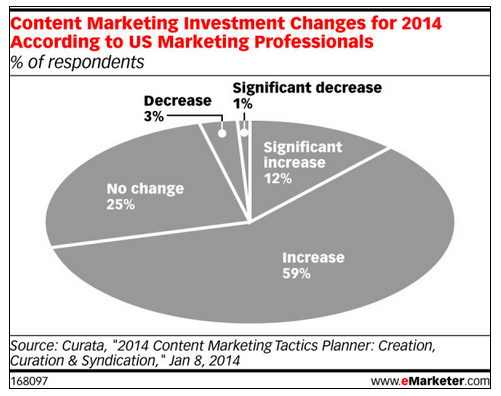
Before the Internet there was radio, magazines, newspapers, and TV.
During these early periods, when businesses want their brands to gain more marketing mileage, they would spend much marketing resources paying for ad placements. Visibility depends on the rates they pay the network or publication. If they pay low, they end up in some obscure timeslot or page where no one is watching or reading. If they want more mileage, they pay more, and more often.
In this brave, new world of the Internet, branding and marketing has taken on a whole new meaning. Mileage and marketing success can be gained not just by how much your marketing budget is but on how relevant your message – your content – is to your targeted audiences. The higher the quality and relevancy of your promoted content, the more you can solicit engagement from your targeted audiences. The more engagement you generate, the higher the chances for conversion – and profit.
The following graph from eMarketer indicates how serious businesses and marketing professionals are about using content marketing to reach targeted customers. These marketers and businesses find content marketing an important and very viable way of generating sales that they are willing to invest more of their marketing budget into generating content.

But conducting a successful content marketing campaign goes beyond creating content and uploading it to as much online channels as your resources can handle. A successful content marketing campaign won’t go for the shotgun approach. Success from such campaigns are a result of fine tuning your content marketing activities, testing which ones will work and which ones will generate favorable responses from your targets.
Just like a thermometer measuring a child’s fever, an effective digital marketer or an online business owner should test and measure the success and effectiveness of their content marketing efforts. Without this thermometer, you will have no way of knowing if all your efforts are generating the results you want or not. Digital Marketing Philippines helps you tackle this dilemma by outlining the following ways how you can measure the success of all your content marketing efforts.
Measurement in Terms of Consumption
Consumption is the most basic and most measurable type of metrics you can use to measure content marketing success. It is straightforward and deals with real figures and statistics. It states how many people actually consumed your content. Website platforms, Google analytics, and social media insights already have these tools available for you to use and the only thing left for you to do is – use them and gain a better insight about your content consumption.
- Website Analytics – a wide variety of tools, free or paid, are available out there that will allow you to measure website metrics according to what you need. Google analytics belongs here, as well as other tools available out there depending on your preference and needs. You can measure page views, unique visitors, popular posts, visitor demographics and a host of other measurable information that you may find relevant for your campaign.
- Facebook Insight – Hey wait! Why are we talking about social media metrics? Isn’t this a content marketing article? Well, if you understand content marketing like what we are teaching here at Digital Marketing Philippines, you will know and understand why it is important to measure social media metrics. Facebook insights are good analytical tools that tell you what content creates the biggest buzz in social media. From overview stats to specific age and gender information, Insights is a great tool you should not overlook.
- Twitter Analytics – If Facebook has one, surely Twitter sports one of its own too. Analytics provides you an insight of what goes on in your timeline, telling you what interactions and engagement goes on so you can focus more on content that will matter to your audience.
- Google+ AllMy+ – Google+ is definitely rocking the social media world, so it is only logical that the team from Google can come up with their own analytics version which they surely din with AllMy+. It is a very useful tool that will tell you relevant Google+ stats that you may find useful. It will tell you metrics about your post, which are most popular, how many are reading and re-sharing your content – and much, much more!
- LinkedIn – Hah! Even LinkedIn joined the analytics fray with its very own Analytics tab that will show you information about your posts, clicks, interactions, impressions and other engagement analytics you will need to know.
What these metrics do is also to tell you which particular content you have that may have a very big impact on your targeted audiences as well as getting their attention with your content, so you can go on and create even more similar content.
Measurement in Terms of Social Sharing
Social sharing is about interaction: between you and targeted customers, as well as with your peers, families, acquaintances and friends. Measuring the extent of social sharing generated by your content is a tactical strategy of creating readership and loyal followers for your brand. As interaction and engagement increase with targeted audiences, so shall the likelihood of generating conversions or sale that will most likely occur.
Measuring social sharing will also tell you what kind of content you are sharing. You will gain a bigger insight on what content will have a bigger impact with social media users. The more “likes” and “shares” a particular content has generated, the more likelihood it can go viral, create more brand awareness, and generate conversion and sales.
Measurement in Terms of Lead Generation
Two main business reasons why people go for digital marketing tools to promote their brand, products and services is to generate leads or to generate sales. Measuring how successful your lead generation efforts are with your content is a challenge and a necessity that will provide you with an insight of how successful you are with your content marketing efforts.
Lead generation occurs when someone perform an action like download an eBook or watch a video after providing valuable contact information with you. This is done through a web form, which you can customize to contain a simple and trackable script that will allow you to view exactly how many of your web visitors actually accessed your page and performed a specific action. The following describes some metric that you can use.
- Sales-Qualified Leads
Sometimes business owners and digital marketers go for massive numbers when qualifying leads and site visitors. What they fail to realize is that success in content marketing simply cannot be your main goal. They fail to realize that the most important step in lead generation is to identify leads that has the most likelihood to become sales. You won’t waste considerable time working on leads that will have no impact on your sales.
- Response Rate from a Call-to-Action
A successful content solicits a certain response from your targeted audiences like taking advantage of a special gift or promo you are offering and filling up information sheets that will convert their visits into leads. Using available tools, you can tract certain metrics like content views, click rates and response rates.
- Identifying Responders that Can Become Customers
Unless you’ve place some restrictions or filters in your lead capture forms, responders can practically come from anywhere in the world but not all can eventually become paying customers. To do this more effectively, you can categorize responders according to these three categories that describes them so well.
- Responders that fit your selection criteria – this is probably the most important filtering and selection criteria that you can use to categorize responders, filtering out leads that will be worth your sales staff’s time for a more comprehensive engagement.
- Responders that Are Not Targeted Customers – When you go through the lead sorting step to identify quality leads from your responders, some will be identified as not relevant to your business or campaign. Yes, you can still send them emails if you want too and if they are still a part of your subscriber list, but don’t spend considerable sales effort as you pass them by.
- Responders that Are in Between – When sorting leads, they can either be useful leads with sales potential, totally irrelevant leads, or somewhere in between. You can put these leads out of the limelight for the time being and focus on quality leads that can turn into sales. When the time comes, they may eventually provide future business opportunities for you.
Measurement in Terms of Sales
The ultimate metrics you’ll need to measure the success of your content marketing campaign would be in terms of sales – how much traffic are converted into paying customers through your content. Whether you have an automated online payment service or process orders directly through online or offline means, you can track sales information as well as other valuable insights that can help you improved your branding – and increase sales even further.
Just like any other digital marketing campaign, your content marketing efforts are set to motion in the first place to generate a particular response from your targeted audiences: consumption, social shares, lead generation and sales. The ability to measure these responses can help you gauge the success of your content marketing efforts, enabling you to make adjustments in your campaign as necessary – and eventually generating the kind of results you want towards the fulfillment of your end goals.
Jomer B. Gregorio is a well-rounded expert when it comes digital marketing. Jomer is also known as a semantic SEO evangelist and practitioner. Check out our Digital Marketing Services today and let us help you in achieving positive and profitable results for your business.
